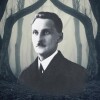Anthony Burgess, author of A Clockwork Orange , argued that novelists fall into two categories: those who put the most energy into creating fictional worlds in their novels, and those who focus on experimenting with language in their works. Stefan Grabiński, a Polish writer of the interwar period, seems to refute the truth of this theory, showing that you can be great in both of these fields.
Bad good starts
Stefan Grabiński was born in Kamionka Stumiłowa in 1887. He made his debut as a student of classical and Polish philology – in 1909 his first collection of short stories titled From Exceptions was published . In the darkness of faith . Grabiński, perhaps fearing criticism, which can be hard to accept, especially for young artists trying to find their niche on the publishing market, decided to publish his first work under the pseudonym Stefan Żalny. Unfortunately, his fears turned out to be fully justified – the work met with a cold reception from critics who did not like Grabiński’s writing style.
After graduating, he tried his hand at a Polish language teacher, teaching in Lviv grammar schools and traveling to Austria, Italy and Romania. Unfortunately, during his student period, he developed a disease that at one time affected many famous writers, from Anton Chekhov, through Franz Kafka, to George Orwell – we are talking about tuberculosis, of course, which forced the writer to undergo for early retirement. Traces of these experiences, like a passionate religiousness, left their mark on his works, giving them an atmosphere of eerieness.
It is worth mentioning that although Grabiński wrote novels, he was famous mainly for short stories that formed closed cycles. He gained recognition from critics after the publication of the volume Na Wzgórzu Róż , in which he proves that it is possible to create a mood of horror and keep the reader in suspense without excessive literalness, thus confirming the truthfulness of Dan Brown’s words, who said that “we are afraid of what we do not know” .
A recipe for horror according to Grabiński
Each writer has his own idea of building tension in the books. The range of possibilities seems endless, but for a genre as heavily exploited as horror, they are quite predictable. Haunted houses, mysterious curses, the sounds of footsteps in an empty room … Readers have seen all these treatments in movies and novels thousands of times. In this context, a particular curiosity may be the style of writing by Stefan Grabiński, who presented unconventional solutions in his stories. The author does not accept shortcuts or common patterns when he wants to scare the reader – we will not find hectoliters of blood or limbs scattered around the room. With his pen, Grabiński paints a seemingly completely normal reality in front of our eyes, showing every detail of the surroundings. Reading his stories can be compared to being stuck in an extremely realistic dream, which is slowly becoming more and more ominous – sensing what awaits us, we try frantically to find some signs that we are dreaming, but the illusion of reality is irresistible. For the time of reading, the reader is at the mercy of the mysterious forces lurking in the world created by the author.
(Ir) rational technique
Today’s reader tends to take technology for granted – no wonder, it surrounds us from every side, so much so that sometimes we feel like its prisoners. However, it should be remembered that Grabiński wrote his stories at the turn of the 19th and 20th centuries, i.e. at a time when modern technology was just beginning to crawl – just a year before the writer was born, the light bulb was invented. The author had a chance to grow up in times of great changes, both technological and social, which is perfectly visible in his works, which show an ambivalent attitude to the revolution that was underway before his eyes.
Although electric trains entered Poland permanently in the 20th century, not everyone had the privilege of using these machines. They made such a strong impression on Grabiński that he wrote a series of twenty-five stories – The Demon of Motion(1919), which brought him the desired success. It is an unusual book in many respects, one of them being the unusual way of selecting heroes. Grabiński proves that people do not necessarily have to be at the center of history. It may as well be…. train. In “The Errant Train”, the reader goes to a fictional city called Horsk – right to the station, famous for its order. Trains run on time and each train is listed in the timetable. Unexpectedly, an intruder appears in this perfect composition. The very moment of arrival of the train heralds a threat:
An unexpected steam engine approaches with dizzying speed; the enormous, green eyes of the machines scatter the darkness with their eerie gaze, the mighty pistons turn with fabulous, possessed agility… […]. Some gigantic, gray mass flies over a row of bodies, an ashen, foggy mass with window blanks into space – you can feel the whirlwind of a devilish draft blowing from these open burrows, you can hear the flapping of madly blown blinds, know the ghostly faces of passengers …
Of course, Grabiński does not avoid human heroes in his stories. In Demon Ruchu, the author shows us the characters of conductors who may seem too normal to the reader to become the heroes of a horror film, but what the writer serves us is quite different from the image of a smiling railway worker who wishes us a nice journey, which is a great example of this. there may be an older conductor, Błażek Boroń, from the story “Smoluch”, who harbored contempt towards passengers:
Boroń basically hated passengers; he was irritated by their “practicality.” For him, there was a railroad for railways, not for travelers. […] In his “region”, which comprised three to four wagons, there was never an overcrowding, that hideous crowd of mobs, which often made friends feel unhappy with life and was a dark spot on the horizon of a gray conductor’s fate. What means he used, along the paths he followed, to achieve this ideal, indestructible for other comrades in the profession, no one knew.
All the stories from the Demon of Motion series are a strange mixture of extraordinary realism and fantasy. On the one hand, the author offers the reader very detailed descriptions of the world of railways, using words taken directly from the dictionary of his employees, on the other hand, it deals a blow to logic, which in the case of such a complex organism as railroads is crucial. The writer’s efforts resulted in the emergence of a new genre, i.e. railroad horror.
Flammable stories
Of course, Grabiński’s interests did not end solely with the field of technology, an example of which is the collection of short stories that appeared three years after the publication of Demon of the Movement . We are talking about the Book of Fire (1922), which is a collection of nine stories oscillating around this very element. In this series, the writer shows nature from an unusual perspective – it is not a panacea for all diseases and worries; in Grabiński’s view, it resembles the contents of Pandora’s box, which begins to do damage as soon as an opportunity presents itself, and sets a human target as its target.
Books of Firewell illustrate the age-old conflict between nature and culture. The protagonists are usually men related to the latter – in Grabiński’s stories we can meet rationalists working as a doctor or scientist, but also men fighting nature in a more literal way – we are talking about firefighters here, of course. Grabiński, as a writer, is not interested in normality, he is much more attracted to any deviation from the norm. In the story “Flame mating”, the author decides to present topics that are still considered taboo in the 21st century, ie incest and pyrophilia. Władysław Kobierzycki, the main character of the story, experiences sexual attraction only in the presence of flames. His love of fire brings ruin not only to his surroundings, but also to the hero himself.
Strongly excited, [Kobierzycki] left his room on the left wing of the house and headed for the exit. Passing through the bedrooms of his relatives, he noticed his cousin, sixteen-year-old Magda, who, half-dressed, had torn from the bed to run away. It was the first time in his life that he felt like a man. This girl, until now completely indifferent to him, whom he had hardly paid attention to until then, suddenly seemed to him strangely desirable.
Women in Grabiński’s prose are also an interesting topic. The protagonist wrote at a time of great social changes, when the fair sex was slowly gaining equal rights. In this context, it is interesting that the writer either completely ignores female figures in his stories, or makes them a femme fatale bringing doom to the main character. Women in the Book of Firethey are usually equated with the destructive element. A good example of this tendency is the short story “Czerwona Magda”, whose protagonist is Magdalena Szponarówna. Despite its inconspicuousness, over time it turns out that the fifteen-year-old girl is endowed with extraordinary powers, which completely displeases the inhabitants of the quiet town and her father. Unfortunately, the lack of control over her supernatural skills causes more and more trouble for the girl, which allows us to believe that Szponarówna is Carrie’s Polish great-grandmother from Stephen King’s novel, and that she has much more on her conscience than blowing one school on fire.
The underrated father of Polish fantasy
In recent years, we can observe an increase in interest in the past – it is enough for a product to have “retro” or “vintage” in its name and its price magically doubles. This trend is visible in all areas of art. He also did not avoid literature. It is difficult to talk about Grabiński in these terms, because the writer does not imitate any style from the past, although some similarities to the works of Edgar Allan Poe can be found in his works. In the case of the author of The Book of Fire and the Demon of MovementThe saying of Stanisław Jachowicz, who wrote “you praise others, you do not know yours” works well. Grabiński is an example of a still underrated writer whose style balances gracefully between being a charming old man inviting the reader to careful observation and a work that is still relevant and tells more about the condition of the present world than we think.
Links to Stefan Grabiński’s stories ( open access ):
Wrong train: https://wolnelektury.pl/katalog/lektura/grabinski-bledny-pociag.html
Czerwona Magda: https://pl.wikisource.org/wiki/C Czerwona_Magda
Płomienne Gody: https://pl.wikisource.org/wiki/P%C5%82omienne_Gody
Smoluch: https://wolnelektury.pl/katalog/lektura/grabinski-smoluch.html
Sources:
http://lubimyczytac.pl/cytat/6093
http://lubimyczytac.pl/cytat/6093
http://nowemysli.pl/choroby-wielkich-pisarzy/
https://culture.pl/pl/tworca/stefan-grabinski
https://www.polskieradio.pl/9/5377/Artykul/1675884,Stefan-Grabinski-i-jego-horrory-kolejowe
https://www.smartage.pl/el-100-pierwsze-lokomotywy-elektryczne-w-polsce/
https://www.theguardian.com/books/booksblog/2007/jul/30/aorbdonovelsfallintotwo


